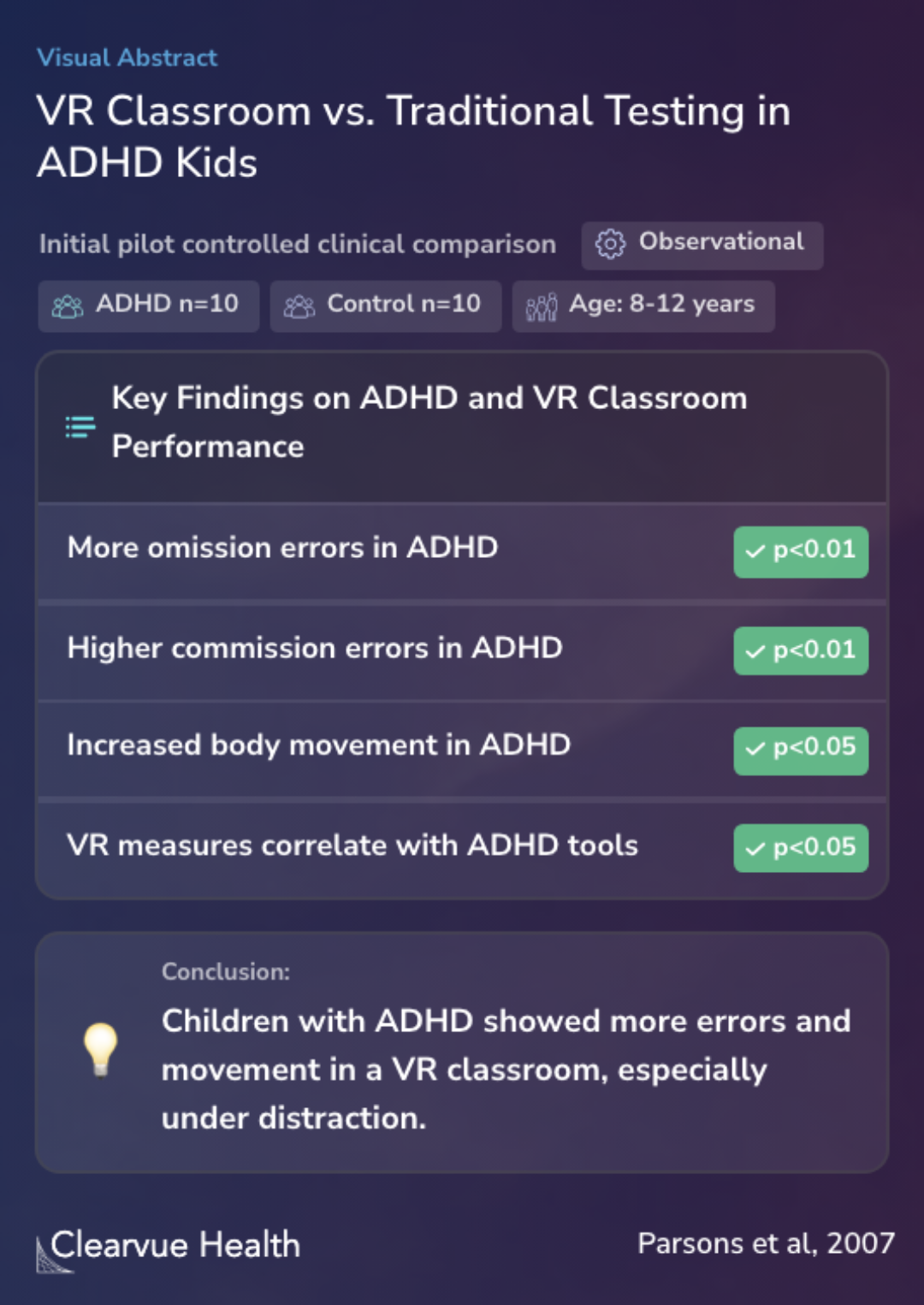A controlled clinical comparison of attention performance in children with ADHD in a virtual reality classroom compared to standard neuropsychological methods
ADHD Children's Attention in VR vs Standard Methods
Parsons TD, Bowerly T, Buckwalter JG, Rizzo AA

Objectives
The study aimed to assess how children with Attention Deficit-Hyperactivity Disorder (ADHD) perform in a controlled environment when faced with distractions. Specifically, the study explored attention performance in a virtual reality (VR) classroom, comparing children diagnosed with ADHD against a control group of children without the disorder.
In this initial pilot study, a controlled clinical comparison was made of attention performance in children with attention deficit-hyperactivity disorder (ADHD) in a virtual reality (VR) classroom.
Methods
The research involved twenty boys, half diagnosed with ADHD and the other half serving as the control group, matched by age and other demographics. The study ensured that both groups were comparable in age, grade level, ethnicity, and handedness, making the findings more focused on the ADHD condition itself rather than other variables. No adverse effects like simulator sickness were reported after the VR sessions, indicating that VR is a suitable medium for this type of research.
Ten boys diagnosed with ADHD and ten normal control boys participated in the study. Groups did not significantly differ in mean age, grade level, ethnicity, or handedness. No participants reported simulator sickness following VR exposure.
Results
In the virtual setting, the ADHD group showed more frequent omission and commission errors and increased physical movement, suggesting a higher level of distractibility compared to the control group. Notably, the VR performance metrics were in line with established ADHD assessment tools, reinforcing the potential of VR environments in assessing behaviors related to attention disorders. However, the small group sizes and the relatively higher intelligence scores of the control group could influence the interpretation of these differences.
Children with ADHD exhibited more omission errors, commission errors, and overall body movement than normal control children in the VR classroom. Children with ADHD were more impacted by distraction in the VR classroom. VR classroom measures were correlated with traditional ADHD assessme...
Evidence Comparison
The findings of this study provide valuable context to established ADHD management strategies, particularly concerning the effectiveness of treatment in real-world scenarios like classrooms. For example, the importance of Parent Training in Behavior Management (PTBM) as the primary intervention for preschool-aged children aligns with observed increased distractibility in children with ADHD under simulated classroom settings. This suggests that interventions should not only manage symptoms but also enhance the ability to handle realistic distractions. Furthermore, the study's emphasis on behavioral therapy resonates with recommendations for school-aged children where a combination of behavioral interventions and medication is advised.
Conclusions
Children with ADHD had more errors and moved more in a VR classroom setting, particularly when distractions were present.
These data suggested that the Virtual Classroom had good potential for controlled performance assessment within an ecologically valid environment and appeared to parse out significant effects due to the presence of distraction stimuli.
Key Takeaways
Context
Readers interested in the broader impacts of distractions on children with ADHD might find the article "Distractibility in Attention/Deficit/ Hyperactivity Disorder (ADHD): the virtual reality classroom" by Adams et al. valuable. This study explores how children with ADHD perform in virtual reality classrooms compared to typical controls, emphasizing the greater effect of distractions on these children, which could significantly influence educational strategies.
For those looking into how ADHD affects daily activities, the article "Effect of Distraction on ADHD" discusses the challenges people with ADHD face with internal distractions and how these affect tasks such as driving. It highlights the sensitivity of individuals with ADHD to distractions in various settings, a vital consideration for both clinical understanding and practical interventions.